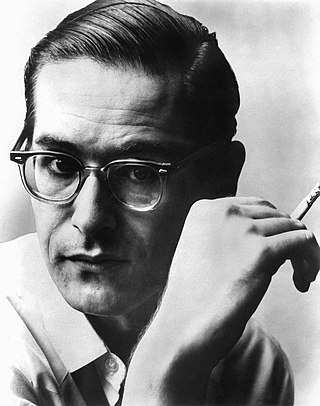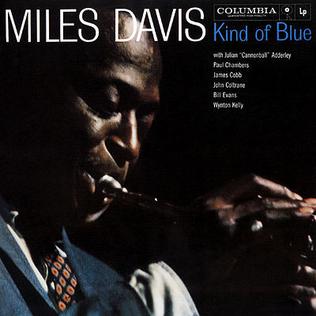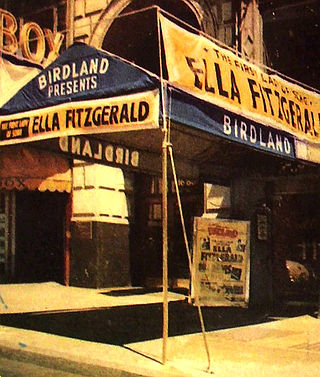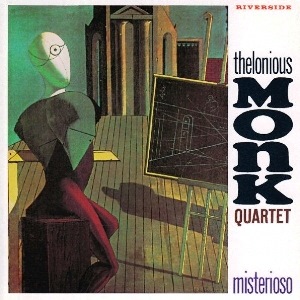Related Research Articles
Modal jazz is jazz that makes use of musical modes, often modulating among them to accompany the chords instead of relying on one tonal center used across the piece.

William John Evans was an American jazz pianist and composer who worked primarily as the leader of his trio. His interpretations of traditional jazz repertoire, his ways of using impressionist harmony and block chords, and his trademark rhythmically independent, "singing" melodic lines, continue to influence jazz pianists today.

Kind of Blue is a studio album by the American jazz trumpeter and composer Miles Davis. It was released on August 17, 1959 through Columbia Records. For the recording, Davis led a sextet featuring saxophonists John Coltrane and Julian "Cannonball" Adderley, pianist Bill Evans, bassist Paul Chambers, and drummer Jimmy Cobb, with new band pianist Wynton Kelly appearing on one track – "Freddie Freeloader" – in place of Evans. The recording took place on March 2 and April 22, 1959 at Columbia's 30th Street Studio in New York City.

James Edward Heath, nicknamed Little Bird, was an American jazz saxophonist, composer, arranger, and big band leader. He was the brother of bassist Percy Heath and drummer Albert Heath.
"Milestones" is a jazz composition written by Miles Davis. It appears on the album of the same name in 1958. It has since become a jazz standard. "Milestones" is the first example of Miles composing in a modal style and experimentation in this piece led to the writing of "So What" from the 1959 album Kind of Blue. The song's modes consist of G Dorian for 16 bars, A Aeolian for another 16 bars, and then back to G Dorian for the last eight bars, then the progression repeats.
The following is a listing of the jazz pianist Bill Evans' original albums. He recorded over 50 albums as a leader between 1956 and 1980 and also played as a sideman on nearly as many more. He broke new ground in many of his piano trio, duet and solo recordings. Several of those won or were nominated for Grammy Awards.
"So What" is the first track on the 1959 album Kind of Blue by American trumpeter Miles Davis.
"All Blues" is a jazz composition by Miles Davis first appearing on the influential 1959 album Kind of Blue. It is a twelve-bar blues in 6
8; the chord sequence is that of a basic blues and made up entirely of seventh chords, with a ♭VI in the turnaround instead of just the usual V chord. In the composition's original key of G this chord is an E♭7. "All Blues" is an example of modal blues in G Mixolydian.
"Freddie Freeloader" is a composition by Miles Davis and is the second track on his 1959 album Kind of Blue. The piece takes the form of a twelve-bar blues in B♭, but the chord over the final two bars of each chorus is an A♭7, not the traditional B♭7 followed by either F7 for a turnaround or some variation of B♭7 for an ending.

Birdland is a jazz club started in New York City on December 15, 1949. The original Birdland, which was located at 1678 Broadway, just north of West 52nd Street in Manhattan, was closed in 1965 due to increased rents, but it re-opened for one night in 1979. A revival began in 1986 with the opening of the second nightclub by the same name that is now located in Manhattan's Theater District, not far from the original nightclub's location. The current location is in the same building as the previous headquarters of The New York Observer.

Misterioso is a 1958 live album by American jazz ensemble the Thelonious Monk Quartet. By the time of its recording, the pianist and bandleader Thelonious Monk had overcome an extended period of career difficulties and achieved stardom with his residency at New York's Five Spot Café, beginning in 1957. He returned there the following year for a second stint with his quartet, featuring drummer Roy Haynes, bassist Ahmed Abdul-Malik, and tenor saxophonist Johnny Griffin. Along with Thelonious in Action (1958), Misterioso captures portions of the ensemble's August 7 show at the venue.
"You Don't Know What Love Is" is a popular song of the Great American Songbook, written by Don Raye (lyrics) and Gene de Paul (music) for the Abbott and Costello film Keep 'Em Flying (1941), in which it was sung by Carol Bruce. The song was deleted from the film prior to release. The song was later included in Behind the Eight Ball (1942), starring the Ritz Brothers. "You Don't Know What Love Is" was again sung by Carol Bruce; it was her third and final film until the 1980s.

1958 Miles is a compilation album by American jazz musician Miles Davis, released in 1974 on CBS/Sony. Recording sessions for tracks that appear on the album took place on May 26, 1958, at Columbia's 30th Street Studio and September 9, 1958, at the Plaza Hotel in New York City. 1958 Miles consists of three songs featured on side two of the LP album Jazz Track, which was released in November 1959, one song from the same session not appearing in the album, and three recordings from Davis' live performance at the Plaza Hotel with his ensemble sextet. The recording date at 30th Street Studio served as the first documented session to feature pianist Bill Evans performing in Davis' group.

Jazz at the Plaza Vol. I is a live album by The Miles Davis Sextet. It was recorded in 1958 and released in 1973 by Columbia Records. Duke Ellington was recorded at the same event and released as the second volume (Jazz at the Plaza Vol. II).
"Waltz for Debby" is a jazz standard composed by pianist Bill Evans. He recorded it as a brief solo piano piece on his debut album, New Jazz Conceptions (1956). Lyrics were later written by Gene Lees. "Debby" in the composition's title refers to Evans's niece, Debby Evans.

Since We Met is a live album by jazz pianist Bill Evans with Eddie Gómez and Marty Morell, recorded at the Village Vanguard in New York City in 1974 and released on the Fantasy label in 1976. Additional recordings from Evans' 1974 Village Vanguard performances were also issued on the album Re: Person I Knew, released posthumously in 1981. The album was digitally remastered and reissued as a CD in 1991 on Original Jazz Classics.

By the end of the 1940s, the nervous energy and tension of bebop was replaced with a tendency towards calm and smoothness, with the sounds of cool jazz, which favoured long, linear melodic lines. It emerged in New York City, as a result of the mixture of the styles of predominantly white swing jazz musicians and predominantly black bebop musicians, and it dominated jazz in the first half of the 1950s. The starting point were a series of singles on Capitol Records in 1949 and 1950 of a nonet led by trumpeter Miles Davis, collected and released first on a ten-inch and later a twelve-inch as the Birth of the Cool. Cool jazz recordings by Chet Baker, Dave Brubeck, Bill Evans, Gil Evans, Stan Getz and the Modern Jazz Quartet usually have a "lighter" sound which avoided the aggressive tempos and harmonic abstraction of bebop. Cool jazz later became strongly identified with the West Coast jazz scene, but also had a particular resonance in Europe, especially Scandinavia, with emergence of such major figures as baritone saxophonist Lars Gullin and pianist Bengt Hallberg. The theoretical underpinnings of cool jazz were set out by the blind Chicago pianist Lennie Tristano, and its influence stretches into such later developments as Bossa nova, modal jazz, and even free jazz. See also the list of cool jazz and West Coast musicians for further detail.
"Nardis" is a composition by American jazz trumpeter Miles Davis. It was written in 1958, during Davis's modal period, to be played by Cannonball Adderley for the album Portrait of Cannonball. The piece has come to be associated with pianist Bill Evans, who performed and recorded it many times.
"Django" is a 1954 jazz standard written by John Lewis as a tribute to the Belgian-born jazz guitarist Django Reinhardt. It was a signature composition of the Modern Jazz Quartet, of which Lewis was the pianist and musical director.
References
- ↑ The notes accompanying «Bill Evans - The Complete Riverside Recordings», published in 1984, give credit to both Evans and Davis: (Davis-Evans) Jazz Horn Music/Warner-Tamerlane Publ. — BMI)
- ↑ See page 20 of the Fall 1993 issue of Letter from Evans Archived 2011-07-17 at the Wayback Machine , where Zindars states that the composition was entirely Evans' handiwork: "I know that [one] is because he wrote it over at my pad where I was staying in East Harlem, 5th floor walkup, and he stayed until 3 o'clock in the morning playing these six bars over and over."
- ↑ "Bill Evans On Piano Jazz" (NPR) at 35m30s. Recorded November 6, 1978; originally broadcast May 27, 1979.
- ↑ Peter Pettinger, How My Heart Sings, Yale University Press (1983), pp. 82–82.
- ↑ "Chet (20 Bit Mastering)" at Amazon.
- ↑ Ted Gioia, The Jazz Standards: A Guide to the Repertoire, Oxford University Press (2012), pp. 37-38.